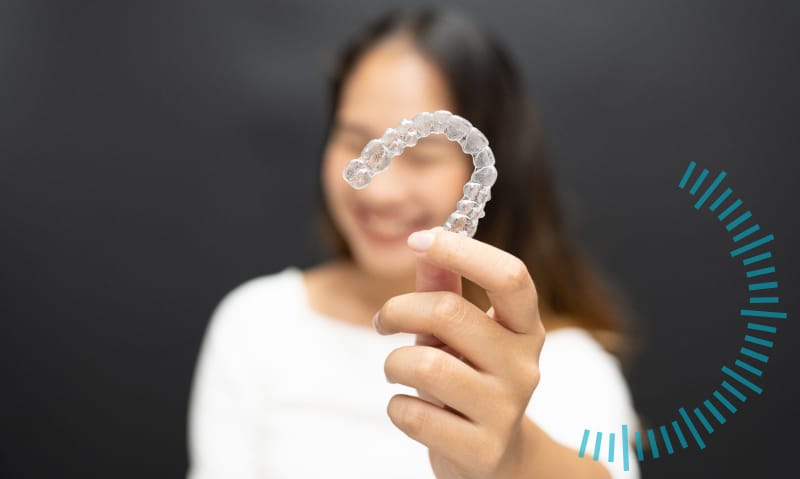How to Take Care of Clear Aligners Versus How to Take Care of Braces

Caring for aligners or braces is as simple as ABC.
When you’re receiving orthodontic treatment with either clear aligners or braces, you can generally rely on these treatments to do most of the work for you. However, there is some basic maintenance you’ll need to do to ensure you maintain proper oral hygiene and that your treatment works as planned.
Fortunately, caring for your aligners or braces is simple. By keeping a consistent routine and following a few easy tips, you can ensure your brand-new smile comes out as healthy and beautiful as possible.
A. How to Take Care of Clear Aligners and Braces
1. Clear Aligners
One of the benefits of clear aligners is how low maintenance they are. Low maintenance does not mean no maintenance, though, so make sure to take good care of yours by:
Wearing Your Clear Aligners
You’re going to need to wear your clear aligners for about 22 hours a day so that your orthodontic treatment can be a success. You can realistically take them out whenever you want to, but you really only want to remove them while you’re eating or drinking and while doing your oral hygiene routine.
Using Your Clear Aligners Tray
Clear aligners are designed to be inconspicuous, which means that when you remove them, they can be quite easy to lose track of.
For this reason, make sure to place them in their aligner tray every time you remove them. It’s a common mistake to accidentally throw them out or misplace them and end up damaging them. These incidents will only prolong your treatment, so be careful to avoid them.
Leaving your aligners out too long can also cause them to warp so they no longer fit in your mouth properly. If you left yours out for a prolonged period and they feel uncomfortable, try to give them some time to reform. But if they’re still bothering you after about 24 hours, consult your dentist.
2. How to Take Care of Braces
Maintenance of your braces mostly concerns oral hygiene, diet, and avoiding certain habits, but there are instances where you may have to address other issues:
Broken Bracket
If a bracket comes loose and is moving freely along the wire of your braces, you’re going to need the help of your dentist to fix it. In the meantime, you can adjust the bracket with a clean pair of tweezers so that it’s in a comfortable enough position and won’t cause irritation.
Broken Wire
A broken wire has much more potential to cause you discomfort than a broken bracket. The first thing you’ll want to do is grab a pair of small pliers and clip off the sharp end, being careful not to let the clipping wind up in your mouth. Once you can safely assume the wire will not poke you, reach out to your dentist for further instructions.
B. How to Clean Clear Aligners and Braces
It’s absolutely crucial that you maintain good oral hygiene during orthodontic treatment. You don’t want your newly straightened teeth to face any issues when treatment is complete. Fortunately, the cleaning process of both clear aligners and braces is a fairly simple one.
1. How to Clean Clear Aligners
You should be brushing your aligners every night with a soft bristle toothbrush and either some toothpaste or a clear liquid soap. When you’re finished, simply rinse them off and put them in their tray.
2. How to Clean Braces
Since you don’t remove your braces, you have to follow your regular oral hygiene routine to keep them clean, only with a little extra care. Make sure to use a soft bristle toothbrush and a floss threader, or even better, a Waterpik.
Because it’s much easier to get food debris stuck in your mouth with braces, try to be as thorough as possible when cleaning your mouth so you don’t miss any particles that may be lodged in hard-to-reach places.
C. What to Eat with Clear Aligners and Braces
It’s important to know what to eat during orthodontic treatment, as the wrong foods can cause some significant issues, particularly with braces.
Clear aligners are removable and therefore don’t require any significant dietary changes. With braces, on the other hand, it’s best to avoid eating overly chewy, crunchy, sticky, or hard foods.
While it may be difficult to make these changes to your diet at first, these changes are only temporary, and adjusting to your new braces-friendly diet as quickly as you can will help prevent issues with your braces that could prolong treatment.
Choosing softer foods will help ensure you’re able to get those braces off and eat whatever you want as soon as possible.
Need an orthodontic dentist near Maryville, MO?
If you’re in need of clear aligners or braces, the experienced team at Compass Dental Group are happy to help. Contact us to learn more about transforming your smile today.